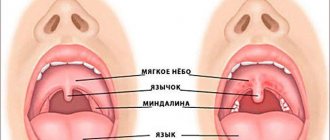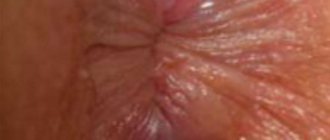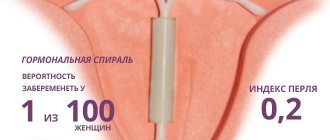Varicose veins are a pathology of the venous walls, in which the condition of the vessel deteriorates, the wall loses its former elasticity, and pathologies and diseases of the circulatory system as a whole develop. The pathological process occurs in superficial and deep vessels, affects the lower extremities, the upper part of the body, and sometimes occurs in the pelvis in women and in the groin area in men.
Varicose veins of the genital organs during pregnancy are a serious condition that worsens the well-being of the expectant mother and negatively affects placentation and the fetus.
According to statistics, the diagnosis of “varicose veins of the genital organs” is made to every third pregnant woman and directly depends on the number of pregnancies and childbirths in the woman’s history.
Enlargement of the pelvic and genital venous organs during pregnancy should be treated. Untreated varicose veins can aggravate the labor process and increase the risk of thrombosis in the postpartum period.
Keeping the disease silent will lead to adverse consequences.
Causes of varicose veins during pregnancy
As a rule, varicose veins during pregnancy begin to appear after the third month of pregnancy for the following reasons:
- hormonal changes begin in the body, causing weakening of the venous wall;
- the uterus and fetus press on the legs and genitals, impeding blood circulation;
- a woman gains weight.
Varicose veins during pregnancy are also influenced by the characteristics of a woman’s body.
Varicose veins of the legs during pregnancy
The main symptoms of varicose veins during pregnancy
Varicose veins during pregnancy begin due to the fact that blood is retained in the lower extremities. When the disease occurs, the veins become pinched and lose their ability to provide the necessary blood flow, which causes blood to stagnate in the veins and stretch them.
!
In the initial stages, varicose veins during pregnancy disappear with virtually no symptoms: only a slight deformation of the veins is externally noticeable.
But in the evening, the legs begin to swell, which is why the woman feels tired, and a feeling of heaviness in the legs may also appear.
With the subsequent development of the disease, patients begin to suffer from cramps of the calf muscles, quite severe pain, and skin itching, which also intensifies at night. In severe stages, varicose veins become noticeably deformed, dilate and protrude above the skin.
It should be noted that severe varicose veins during pregnancy with visible deformation of the veins can pass almost painlessly, while minor external manifestations are often combined with serious pain. .
Women often complain of varicose veins during pregnancy in the groin area, which is characterized by symptoms such as abdominal pain, deformation of the labia, discomfort during sexual intercourse, etc. We will talk about varicose veins of the pelvic organs during pregnancy in more detail below.
Expert opinion
Fortunately, varicose veins that occur during pregnancy often go away after the baby is born, but not always. This is due to the normalization of hormonal levels and weight.
Vascular surgeon, phlebologist
Osipova Ekaterina Yakovlevna
Forms of the disease in pregnant women
Vein diseases can have different localization, severity, and slightly different symptoms. To determine the type of lesion, the doctor conducts an examination and prescribes a series of tests that will help in obtaining the most complete picture of health. Since this disease especially often occurs in the veins of the lower extremities, with all the available provoking factors during pregnancy (increasing body weight, hormonal changes, decreased physical activity), it is localized primarily in the legs.
There may also be congestion of the veins of the pelvic organs, which are aggravated during natural childbirth with varicose veins. To detect this type of pathology, you should promptly pay attention to the following characteristic manifestations of the disease:
- an increase in the volume of the labia minora and a change in their color - they acquire a bluish tint;
- painful urination;
- numbness in the perineal area;
- feeling of dryness in the external genitalia;
- the appearance in the tissues of the labia of painful nodes that have increased in volume of the labia.
The listed manifestations are aggravated by unpleasant sensations that intensify after any type of physical activity, pain that is transmitted to the sacrum and lower back. The manifestations are so characteristic that the diagnosis of the disease can be made without further examination, however, to confirm the diagnosis, the doctor may prescribe studies such as a blood coagulation test and ultrasound of blood vessels and veins.
Forms of varicose veins differ in their location, but their symptoms are mostly similar. By examining the affected area, the doctor determines the presence of diseases of the veins and blood vessels and the degree of neglect. In addition to damage to the veins of the groin area, varicose veins of the uterus can develop, which requires constant attention from the attending physician for timely therapeutic intervention, as well as varicose veins in the vagina.
Varicose veins of the uterus
This form of damage to the veins and blood vessels, such as pelvic varicose veins, which is especially often diagnosed during pregnancy (in the second half, when the uterus rapidly begins to grow in size), is accompanied by an increase in the size of the veins and the loss of their walls’ natural elasticity. Enlargement of the uterus with fetal growth leads to a significant load on the veins of the whole body, and the pelvic organs in the first place; At the same time, a pregnant woman asks the question: with varicose veins of this organ, is it possible to have a natural birth?
To answer this question, the doctor examines the condition of the veins of the pelvic organs and groin area, which makes it possible to identify the need for surgical intervention in the form of a cesarean section. Since it is the uterus that receives the greatest load during pregnancy, it is necessary to constantly monitor changes in its condition throughout the period of pregnancy, making timely adjustments to the therapeutic and supportive effects.
Damage to the groin area
Manifestations of varicose veins in the groin area are accompanied by the same characteristic manifestations as when the lesion is localized in another part of the body. With varicose veins of the perineum, there is the appearance of severe soreness of the labia after physical activity, an increase in their size, changes in skin pigmentation, and childbirth in advanced forms of the disease is preferably carried out in the form of a cesarean section.
Genital varicose veins of the labia are one of the most common types of damage to the blood vessels in the groin area of a pregnant woman, which poses a real danger during natural childbirth. Intensification of characteristic symptoms, the likelihood of a blood clot breaking off and blockage of a neighbor or vein can become a danger to the life of a pregnant woman. Whether it is possible to give birth yourself with varicose veins detected in the tissues of the labia can only be decided by the attending physician.
Disease of the lower extremities
It is the legs that are primarily affected when varicose veins develop. A decrease in the degree of elasticity of the veins, their loss of elasticity leads to the formation of venous nodes that protrude above the surface of the skin of the legs and have increased sensitivity to mechanical influences. Varicose veins especially often develop on the legs during pregnancy, which is due to a constant increase in body weight, and childbirth in this case can be carried out either naturally with minor external manifestations of pathology, or by cesarean section with an advanced form and significant damage to the walls of the veins.
It is quite acceptable to give birth naturally if you have varicose veins of the lower extremities, but the decision about whether you can give birth yourself with existing varicose veins should only be made by your attending physician. It is he who, based on an external examination, test results and vascular ultrasound, will receive a complete picture of the disease and assess the degree of risk during a certain type of childbirth.
Varicose veins of the vagina
The vaginal area is affected by varicose veins somewhat less frequently than the tissue of the lower extremities and uterus. However, this possibility is present with any deviations in the condition of the walls of veins and blood vessels, with a hereditary tendency to pathological changes and disorders in the circulatory system.
When a pubic change in the condition of the vessels is detected, and varicose veins of the legs are in an advanced degree, it is recommended to carry out childbirth by cesarean section: this way the veins of the vagina and all birth canals will be less injured, and there is a lesser risk of developing complications for both the pregnant woman and for a newborn.
Varicose veins during pregnancy: why is it dangerous?
Symptoms and possible consequences of varicose
veins during pregnancy Varicose veins are accompanied by thinning of the venous wall. In this case, varicose veins appear on the leg, which are called “spider veins”.
“Stars” are small vessels that do not protrude above the skin and look like a lilac or blue cobweb. The main veins may also dilate.
In addition to cosmetic defects, the disease can be accompanied by serious complications. If we talk about the dangers of varicose veins during pregnancy, then first of all we need to note the risk of blood clots, ulcers and bleeding, which pose a threat to life.
!
It is necessary to pay special attention to the prevention and treatment of varicose veins in advance.
To avoid the development of varicose veins, expectant mothers are advised to wear compression garments and use creams and gels to strengthen the venous wall, restore blood circulation and relieve inflammation.
Causes
After fertilization, a woman’s body undergoes dramatic changes. Most of all, these processes affect hormonal levels: the level of progesterone in the blood increases significantly, which protects the embryo from leaving the uterine cavity. However, at the same time, this substance has a negative effect on the vascular wall, through a “relaxing” effect on its muscles.
Subsequently, the risk of sudden varicose veins increases significantly. Thus, the vessels seem to “overstretch”, making it difficult for them to push out blood, which, in turn, leads to the occurrence of stagnation.
Weight gain and decreased physical activity of the expectant mother also aggravates the situation. These changes contribute to the development of varicose veins in pregnant women in later stages. In addition, the course of the disease is often complicated by the occurrence of thrombosis. Before childbirth, the body “prepares”: to prevent a woman from losing a lot of blood, the vascular system secretes special cells that stop bleeding. However, the likelihood of blood clots forming against the background of existing varicose veins becomes extremely high.
For the normal development of the fetus in the mother’s womb, it requires many nutrients, which naturally constantly flow from the “adult” organism to the developing one. Against the background of such changes, deficiencies of the most important elements and compounds may occur: iron, magnesium, vitamins and others. This “depletion” weakens the tone of the vascular wall. Thus, in combination with other negative factors, deficiencies also lead to venous insufficiency.
Varicose veins of the labia during pregnancy are a common problem.
Almost every second woman complains of varicose veins in the perineal area during pregnancy, which is considered one of the most common problems. Even minor varicose veins of the genitals during pregnancy provoke discomfort, enlargement and pathological deformation of the veins in the genital area. The labia become deformed and the affected areas may change color. The skin becomes irritated and dry, which causes discomfort during sexual intercourse.
Varicose veins during pregnancy in the labia area often frighten patients, but if you react in time and start treating it in the early stages, then there will be no additional problems or complications during childbirth. If the expectant mother has discovered the above signs, she should inform the gynecologist as soon as possible.
Expert opinion
Varicose veins of the perineum and pelvic veins during pregnancy can be dangerous due to the risk of tissue rupture and heavy bleeding during childbirth. If the disease is at a late stage, a cesarean section may be recommended instead of a natural birth.
Vascular surgeon, phlebologist
Osipova Ekaterina Yakovlevna
How to deal with genital varicose veins during pregnancy? Treatment and prevention of varicose veins on the labia usually do not require much effort. Women are advised to move more, walk, go to the pool, eat right and use venotonic drugs.
In the vast majority of women, such varicose veins go away on their own after pregnancy, but the very presence of the problem indicates that the woman has a tendency to this disease, and she should pay attention to regular prevention.
Prevention methods
Effective measures for the primary prevention of perineal varicose veins are:
- regular examination by an obstetrician-gynecologist;
- daily walks;
- taking a contrast shower;
- nutrition to prevent constipation;
- physiotherapy.
Genital varicose veins are a completely curable pathology. Modern medicine can reduce the severity of painful symptoms and alleviate a woman’s condition. To do this, you need to diagnose the disease in time and seek the help of a specialist.
Share the article on social media. networks:
Varicose veins of the uterus during pregnancy: the most dangerous type of disease
Varicose veins of the uterus - the walls of the uterine vessels become thinner, the veins become deformed, lengthen and normal blood flow is disrupted. In most cases, the first signs of the disease appear already in the second trimester and subsequently increase.
The disease can progress quickly and be accompanied by complications. If we talk about the dangers of uterine varicose veins during pregnancy, then first of all we need to list such complications as placental insufficiency, various fetal pathologies, thrombophlebitis, ovarian vein thrombosis and even miscarriages. An illness with complications becomes an indication for cesarean section.
It is advisable to know what to do to identify such varicose veins during pregnancy at an early stage. It is difficult to diagnose the disease, since in the initial stages it develops unnoticed: the main symptom is considered to be severe and frequent pain in the lower abdomen. Since specific manifestations of the disease are difficult to determine without special equipment, the problem is diagnosed using hardware tests. If the diagnosis is confirmed, the woman should be under the constant supervision of a phlebologist.
The danger of varicose veins during pregnancy
It is worth noting that dilation of the uterine veins more often occurs in those expectant mothers who lead a sedentary lifestyle, perform heavy physical work, and are forced to sit or stand for a long time at work. Also, the likelihood of the disease is increased by previous gynecological diseases (for example, endometriosis), menstrual irregularities, increased estrogen levels, the use of hormonal contraceptives, and heredity.
The disease may be accompanied by varicose veins of the vagina and pelvic organs during pregnancy.
!
Treatment of varicose veins of the uterus is carried out surgically and therapeutically. The method is chosen taking into account the individual characteristics of a particular patient.
With the therapeutic method of treatment, the patient is prescribed special drugs for the treatment of varicose veins during pregnancy, which help regulate the tone of the uterine veins and improve trophic uterine processes. These include venotonics, as well as antiplatelet agents and vitamin complexes (Normaven) to maintain the strength and elasticity of blood vessels.
Women are also prescribed physical therapy, the use of compression garments and latex pads.
Surgical treatment of varicose veins during pregnancy is advisable in the later stages of the disease with severe pain and the necessary indications for surgery.
Prevention of varicose veins during pregnancy
All measures to prevent varicose veins of the lower extremities come down to two main areas - improving blood circulation and reducing stress on the legs. This is necessary for both patients with symptoms of the disease and women who have not yet noticed any signs of the disease. Every expectant mother, starting from the second trimester, needs to use a prenatal bandage. It supports the uterus and helps relieve pressure on the veins of the pelvis and legs.
Prevention of varicose veins during pregnancy
On the recommendation of a doctor, one of the main preventive measures is added to the bandage - compression tights and stockings for the treatment of varicose veins during pregnancy. Such products compress the dilated veins of the legs, improve blood circulation, and restore normal blood flow. Thanks to compression, the risk of developing blood clots is reduced. These stockings are usually worn throughout pregnancy and the first months after the birth of the child.
Your attending physician, a phlebologist, will help you choose the right compression products. He will select the compression necessary for the patient and tell you in what position to put on the stockings correctly.
To prevent varicose veins, you need to choose loose clothing that does not compress the body and does not interfere with blood circulation in the legs. Ideal shoes are with a small heel of 3 to 5 cm.
Pregnant women should carefully monitor their weight
Physical exercise will help significantly improve blood circulation in the legs; walking is very useful. A woman needs to regularly unload her legs and give them rest. During the day, you should lie down several times so that your legs are in an elevated position, which ensures the outflow of lymph and blood from them.
In addition, women should perform simple exercises with their legs every day: imitating pedaling on a bicycle, rolling from toe to heel and back, lifting on their toes, and circular movements of the feet. You can do foot exercises while sitting or lying down: this does not require much effort.
!
It is strongly recommended not to cross your legs or cross your legs when sitting.
You should also avoid standing for long periods of time. If this cannot be avoided, you need to rise on your toes from time to time. This recommendation should be followed by all women, regardless of their tendency to varicose veins. It is also very useful for varicose veins during pregnancy to visit the pool at least 2 times a week.
Expectant mothers should monitor their weight gain, as extra pounds have a negative impact on the condition of the veins. It is necessary to be careful about your diet, consume more fiber and give up canned foods, anything fried, smoked, sweet, milk and dairy products, bread, as such dishes contribute to blood thickening and lead to problems with blood formation.
Varicose veins during pregnancy
The basis of the diet of a woman who has discovered signs of varicose veins during pregnancy should consist of vegetables, meat, fish and eggs. Introducing certain foods into your diet will help improve blood circulation and minimize the risk of developing blood clots:
- lemon;
- tomato juice;
- seafood;
- garlic;
- cranberry;
- sea buckthorn.
Along with special vitamin complexes, special gels, creams and ointments for the feet help in the early stages of the disease. It is better to give preference to products with natural ingredients that normalize blood circulation and are safe for expectant mothers. For example, during pregnancy you can use Normaven cream, which has undergone clinical trials that have confirmed its safety and effectiveness. The testing of the product, which proved its safety, took place at the State Health Institution “City Clinic No. 49”, in the antenatal clinic No. 12. It was proven that with daily use of the cream for three months there was a noticeable reduction in the severity of the vascular pattern, the disappearance of cramps, feelings of fatigue and heaviness in the lower extremities.
Effective treatment
Currently, there are many remedies for varicose veins for pregnant women. But prescribing them to yourself is very dangerous. Because many of the drugs have serious contraindications. The doctor will prescribe a suitable treatment that does not harm either the mother or the baby.
Therapy for varicose veins in pregnant women usually consists of drugs taken orally and ointments for external use. But it’s worth paying attention: some of them cannot be used in the first trimester.
Venotonics taken orally include:
- Phlebodia;
- Detralex;
- Troxevasin;
- Ginkor Fort;
- Venoruton.
Creams for varicose veins are prescribed:
- Lyoton;
- Troxerutin;
- Hepatrombin;
- Heparin ointment;
- Venoruton.
For hemorrhoids, pregnant women are prescribed special rectal suppositories:
- Betiol;
- Relief;
- Sea buckthorn;
- Hepatrombin;
- Glycerin;
- Methyluracil;
- Natalsid;
- Posterizan et al.
You can also use traditional medicine recipes to treat varicose veins in pregnant women. But first you need to consult with your doctor, because many of these recipes can be harmful to the baby’s life.
Folk methods of struggle
Here are some of the useful traditional medicine recipes for pregnant women:
- Apple vinegar. It can be rubbed onto areas of the legs affected by varicose veins, or taken orally, but only in a special dosage. You should add no more than a teaspoon of vinegar to a glass of water and drink it once a day. Within a month of such treatment, positive changes will appear.
- Horse chestnut. This plant always ranks first among the remedies for treating varicose veins. Because it perfectly strengthens the vascular wall, relieves swelling, relieves cramps and heaviness in the legs. In consultation with your doctor, you can rub horse chestnut tincture on your veins and drink it internally. You need to take the tincture twice a day, a certain number of drops prescribed by your doctor. After ten days you need to take a break. Then the reception can be repeated.
- Green tomatoes. You need to cut the tomato in half lengthwise, then apply it to the sore areas of your legs. You need to hold it until a burning sensation appears. Some people tie them to their feet overnight and wash them off with cold water in the morning.
- You can rub your feet with Kalanchoe tincture; you should do this every day for three months.
- Potato. You need to grate several raw potatoes on a coarse grater, apply the paste to a cloth and make a compress. Bandage it tightly and remove it after 4 hours.
- Sagebrush. Grind wormwood flowers until smooth, dilute with milk and apply to feet. Bandage tightly, remove the compress after 2 hours.
Physiotherapy
Therapeutic gymnastics also helps well with varicose veins. There are several exercises for pregnant women that can reduce the occurrence of this disease.
Here are some of them:
- Sit on a chair, perform circular movements of the feet with each leg in turn. Repeat 10 times.
- Lying on your back, carefully raise your legs and make leg movements that imitate riding a bicycle.
- While standing, rise on your toes and roll onto your heels. Repeat 10 times.
- Walk in place without lifting your socks off the floor for 2 minutes.
It is very useful to go down the steps. It is also important to spend a lot of time walking in the fresh air - walking normalizes blood flow. After exercise, you need to lie on your back with your legs raised 20 degrees.










